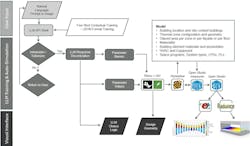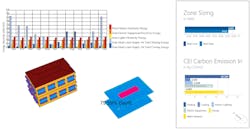This blog post was authored by Mo Elsayed Senior Associate and Senior Building Performance Analyst, Page; Jill Kurtz, LEED AP BD+ C, Principal and Director of Building Sciences, Page; and Justin Shultz, Ph.D., BEMP, LEED GA, Associate Principal and Building Performance Director, Page.
The Building Performance team at Page, now Stantec, launched a three-part series on overcoming a frustrating chokepoint in the design process. The first installment introduced its innovative AI-driven framework for quick energy modeling and explained its transformative impact on making building energy modeling (BEM) faster, smarter, and more performance-focused. The second installment explores further, showing how generative AI can help automate and speed up BEM, turning a once tedious task into a catalyst for real-time, performance-based decision-making.
For decades, the future of sustainable building design has depended on closing the gap between creativity and performance, but that gap has persisted–until now. Part one of this series explored how building energy modeling (BEM) has traditionally been a bottleneck in the design process.
Architects aim to iterate quickly and test ideas for energy efficiency early, but conventional energy simulations are slow, complex, and labor-intensive.
As a result, performance analysis often occurs late or not at all, missing opportunities for optimization. A game-changing solution has emerged: using generative AI as a creative partner to automate and accelerate energy modeling. The Building Sciences team from Page, now Stantec, created an AI-assisted framework that could instantly turn an architect’s sketch or description into a functional energy model, providing real-time feedback on energy use, carbon impact, and daylighting. This approach promises to shorten the feedback loop between design and performance, enabling rapid iteration without incurring time penalties.
In short, it demonstrates how AI can transform energy modeling from a tedious bottleneck into a source of inspiration.
Before diving into the solution, a quick recap of why this innovation is so critical. Most buildings today do not benefit from early energy modeling at all. Over 80% of commercial buildings are small (less than 25,000 sf), and the complexity and cost of BEM have been a big deterrent for those projects.
When modeling is too slow or expensive, design teams often skip it, missing out on optimizations that could greatly improve efficiency. On larger projects, traditional workflows required specialist modelers and long turnaround times (sometimes hundreds of hours) by which point, the design might have already moved on. To make high-performance design the norm, not the exception, a faster, more accessible way to evaluate energy use during design is needed. Generative AI is the breakthrough that makes that possible.
Reinventing the energy modeling process with AI
To tackle this long-standing, ongoing issue, Page’s Building Sciences team sought to reimagine energy modeling by integrating it into the architect’s process, transforming it from a late-stage hurdle into a driver of performance. At its core is a large language model (LLM), an AI trained on building science knowledge that can translate an architect’s inputs, like a natural-language description of a building or of an image of a sketch, into energy simulation parameters. Simply put, the AI acts like a highly skilled translator or technician: describe a building concept (e.g., “a 10-story office tower with floor-to-ceiling glass, high-efficiency lighting, in Austin, Texas”), and the AI can quickly generate a corresponding complete energy model behind the scenes.
This AI-driven process addresses the pain points of traditional methods in several ways:
- Speed, precision, and automation: The LLM quickly handles the tedious setup of the energy model by generating a building’s geometry, systems, and assumptions for simulation in seconds, tasks that a human modeler might spend days drawing zones, assigning construction materials, and inputting data. The models are then run automatically through simulation engines. In tests, the AI-generated models have consistently produced valid simulations with 100% accuracy, without errors like forgotten windows or miswired HVAC systems, resulting in error-free models ready to go.
- Technical complexity: The AI framework simplifies energy modeling by addressing long-standing issues related to quality and scalability that traditionally need specialized expertise to operate. Designers can describe the buildings in natural language when entering data into the model, and the AI infer detailed parameters based on a consistent knowledge base of industry standards and codes like ASHRAE 90.1 or IECC, filling in reasonable assumptions for unspecified details. This approach ensures models are not only quick but also code-compliant and realistic, avoiding any unrealistic assumptions (no magical super-insulation or perpetual-motion HVAC appearing unless you ask for it!). By lowering the skill barrier, the tool democratizes energy modeling, giving architects or engineers the ability to receive performance feedback without waiting for a specialist to build a model.
- Switching environments: The AI is embedded in the same parametric design software architects use for 3D modeling, leveraging the Ladybug/Honeybee toolkit connected to EnergyPlus and Radiance. This allows designers to iterate within their design software without exporting or switching contexts, with performance results updating alongside their drawings. For example, an architect can adjust a building’s orientation or window size, input a quick prompt, and get an updated energy use projection within minutes. This seamless integration keeps the focus on design rather than on file management, creating a fluid loop: design, receive feedback, refine, and repeat. The process fosters an iterative, interactive relationship where analysis informs creativity at every step.
- Objectivity: Partial insights on building performance can be misleading without the bigger picture, like energy versus daylight performance. Page’s framework extends beyond energy use, like HVAC or annual energy costs, to include daylight and solar analysis via Radiance, offering a holistic view of performance. Traditionally, daylight simulations require separate models or specialists, but here the same AI input can spawn multiple models, providing multi-dimensional feedback on energy efficiency and daylight availability from a single prompt. This integration helps avoid tunnel vision, such as trading off too much daylight to save energy, and encourages balanced high-performance design.
By simplifying and accelerating the modeling process, this approach fosters broader accessibility, enables greater participation from users with varying levels of experience, and ensures more precise, real-time analysis during early design phases.
- Page's Building Performance team: Mo Elsayed, Jill Kurtz, and Justin Shultz
How the AI-driven workflow unfolds step by step
An AI-assisted energy modeling session begins with either a simple prompt from the architect, such as a text description (“a five-story, 50,000-sf office in Dallas with floor-to-ceiling glazing and VRF HVAC”) or a rough sketch or 3D massing. This input is high-level and accessible.
AI interprets the prompt, identifying key parameters such as location, building size, number of stories, and system types. It fills in missing information using standard assumptions based on building codes and climate data. The result is a complete and simulation-ready description of the building. Using this structured data, the AI writes EnergyPlus input files for energy modeling and Radiance files for daylight analysis. These outputs are also presented in natural language, ensuring transparency and human readability in seconds.
Once the model is generated, simulations run automatically via APIs, either locally or in the cloud. Designers do not need to interact directly with simulation engines. Within minutes, outputs such as annual energy use and daylight metrics are available. This performance data is visualized in user-friendly dashboards or overlays within the design environment. The rapid feedback loop encourages immediate design iteration. For example, if a design exceeds its energy target, the architect can adjust the glazing or orientation and prompt the AI again. Multiple variations can be explored in a single session.
This workflow drastically reduces turnaround time, promotes experimentation, and improves consistency by generating models from the same knowledge base, reducing variability between modelers and minimizing errors. Assumptions are applied uniformly, making comparisons between options more reliable. AI enables scalability, generating and simulating multiple design alternatives, building portfolios or districts, supporting urban analysis and policy development. This automation democratizes energy analysis, embedding results in the design process and making them accessible to all stakeholders. Engineers, architects, and owners can evaluate options collaboratively, aligned around performance from the start.
Toward high-performance by default
With the bottleneck of slow modeling removed, a new era is emerging where every project can be a high-performance project by default. Tools like generative AI make sustainability a natural, automatic part of design, rather than a specialty service. At Page, the goal is that for any design—big or small—to be quickly evaluated for energy, carbon, daylight, and more, using those insights to improve the outcome. When every decision is performance-based, the industry can avoid missteps like oversized mechanical systems or a glare-filled glass façade, before they happen. This shift makes performance simulation an invisible guide, not an extra step. The end result is not just faster design iteration, but better buildings; buildings that meet stringent energy and carbon goals without endless back-and-forth or guesswork.
About the Author
Page
With roots extending back to 1898, Page provides architecture, interiors, planning, consulting, and engineering services throughout the United States and around the world. The firm’s diverse, international portfolio encompasses academic, advanced manufacturing, aviation, and civic/community/culture sectors as well as government, healthcare, hospitality, mission critical, multifamily residential, office, retail/mixed-use, science/technology and workplace projects. Page Southerland Page, Inc. has 1,300 employees across multiple offices in every region in the United States as well as abroad.
Learn more about the firm at pagethink.com. Follow Page on Facebook, Instagram, LinkedIn,


